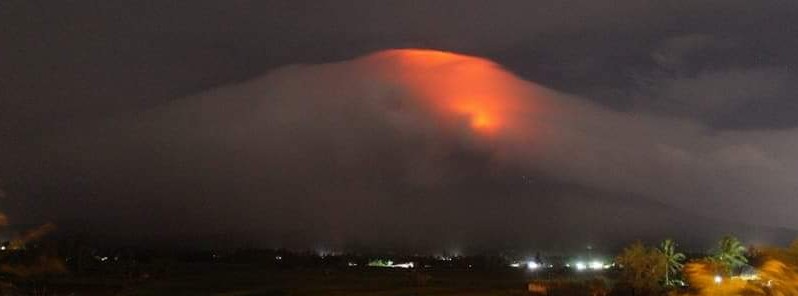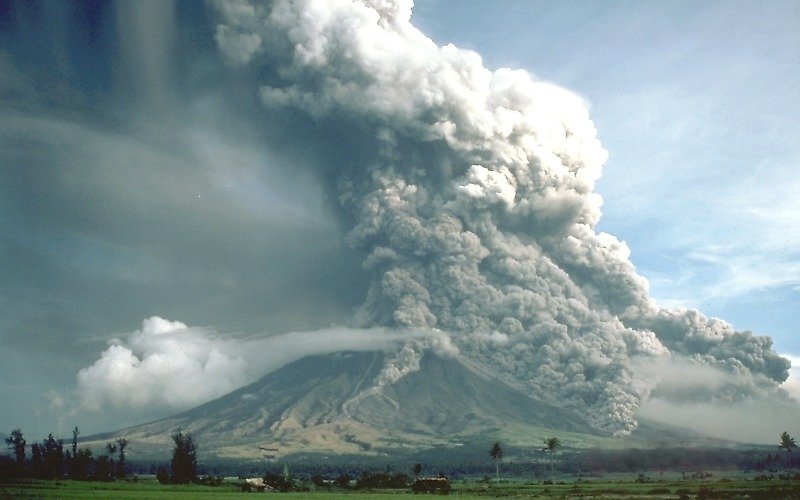Mayon volcano alert level raised to 3, lava flow observed, Philippines

Following the first eruption of Mayon volcano since 2014 on Saturday, January 13, 2018, the Philippine Institute of Volcanology and Seismology (PHIVOLCS) has raised the volcano's Alert Level to 2 and then to 3 on Sunday, January 14, 2018. This means that Mayon is exhibiting relatively high unrest, that magma is at the crater and that hazardous eruption is possible within weeks or even days.
For the past 24 hours, Mayon volcano in Albay Province has noticeably increased its unrest, PHIVOLCS reported 12:00 UTC today. After three phreatic (steam-driven) eruptions and 158 rockfall events between 08:21 UTC, January 13 and 11:25 UTC, January 14, Mayon's summit crater is now exhibiting bright crater glow that signifies the growth of new lava dome and beginnings of lava flow towards the southern slopes.
This increased activity forced PHIVOLCS to raise the Alert Level from 2 to 3 on January 14. This means that Mayon is exhibiting relatively high unrest, that magma is at the crater and that hazardous eruption is possible within weeks or even days.
"It is therefore recommended that the 6-km [3.7 miles] radius Permanent Danger Zone (PDZ) and a 7-km [4.3 miles] Extended Danger Zone (EDZ) on the southern flank be enforced due to the danger of rockfalls, landslides and sudden explosions or dome collapse that might generate hazardous volcanic flows," PHIVOLCS said.
Increased vigilance against pyroclastic density currents, lahars and sediment-laden streamflows along channels draining the edifice is also advised.
Civil aviation authorities must also advise pilots to avoid flying close to the volcano's summit as ash from any sudden eruption can be hazardous to aircraft, the agency said.
Based on the seasonal wind pattern, ashfall events may most likely occur on the southwest side of the volcano.
We need your prayers
Mayon Volcano ATM
Legazpi City, Albay
Photo by Earl Recamunda pic.twitter.com/zsIL8qyYQ1— アンドレイ (@AndreiTubice) January 14, 2018
That moment you looked outside your window and felt you're in LOTR set and the eagles are flying to save you anytime soon.#MayonEruption #mayonvolcano#MayonVolcanoAlertLevel3 #Mayon
Eli Casim pic.twitter.com/GyNVFZv19P
— theo talks (@theoconomist) January 14, 2018
Beauty and a Beast#mayon #mayonvolcano
Alert Level 3 raised pic.twitter.com/RuTbEDihaR
— Aekkaphob Sajjatantitham (@lloydmaronilla) January 14, 2018
Mayon Volcano at Alert Level 3 pic.twitter.com/Rl1SwfV7Gk
— ey (@anjDexplorer) January 14, 2018
The last eruptive episode of this volcano started on August 12, 2014 and ended on October 19, 2014.
Mayon's alert level was raised from 0 to 1 on September 8, 2016. Although no crater glow has been observed at the time, PHIVOLCS warned a phreatic explosion that could lead to a big explosive eruption can happen anytime. "The abnormal activity is similar to what happened to the Mayon eruption of 1984 [VEI 3]," Eduardo Laguerta, PHIVOLCS resident volcanologist in Bicol said.
No casualties were recorded from the 1984 eruption (ash column up to 15 km / 49 200 feet a.s.l.) after more than 73 000 people were evacuated from the danger zones as recommended by PHIVOLCS. But in 1993, pyroclastic flows killed 75 people, mainly farmers. More than 1 200 people were killed in its most violent eruption in 1814.

Pyroclastic flows at Mayon Volcano, Philippines, 1984. Pyroclastic flows descend the south-eastern flank of Mayon Volcano, Philippines. Maximum height of the eruption column was 15 km (49 200 feet) above sea level, and volcanic ash fell within about 50 km (31 miles) toward the west. There were no casualties from the 1984 eruption because more than 73 000 people evacuated the danger zones as recommended by scientists of the Philippine Institute of Volcanology and Seismology. Credit: USGS / C.G. Newhall
Geological summary
Beautifully symmetrical Mayon volcano, which rises to 2 462 m (8 077 feet) above the Albay Gulf, is the Philippines' most active volcano. The structurally simple volcano has steep upper slopes averaging 35-40 degrees that are capped by a small summit crater. Historical eruptions at this basaltic-andesitic volcano date back to 1616 and range from strombolian to basaltic plinian, with cyclical activity beginning with basaltic eruptions, followed by longer term andesitic lava flows.
Eruptions occur predominately from the central conduit and have also produced lava flows that travel far down the flanks. Pyroclastic flows and mudflows have commonly swept down many of the approximately 40 ravines that radiate from the summit and have often devastated populated lowland areas.
Mayon's most violent eruption, in 1814, killed more than 1200 people and devastated several towns. (GVP)
Featured image credit: Mayon volcano, Philippines on January 14, 2018. Credit: Andrei Tubice

Commenting rules and guidelines
We value the thoughts and opinions of our readers and welcome healthy discussions on our website. In order to maintain a respectful and positive community, we ask that all commenters follow these rules.